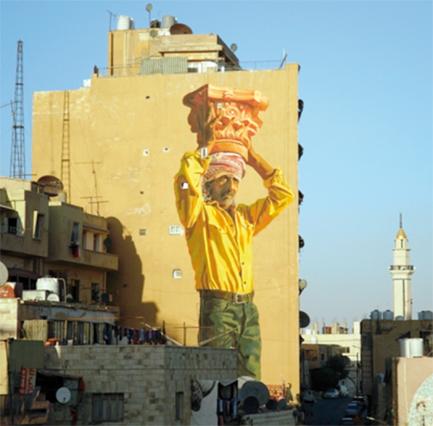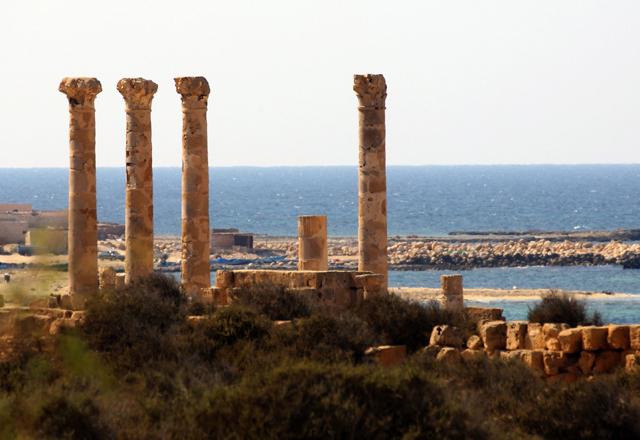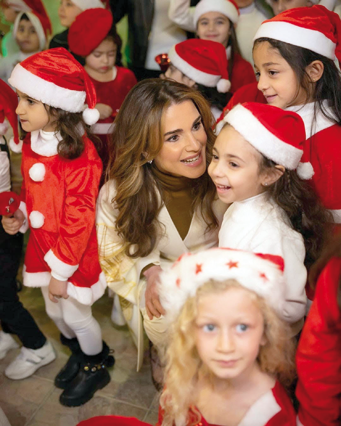You are here
Jordan’s ‘working souls’ recognised at global street art competition
By Artemis Sianni-Wedderburn - Feb 20,2022 - Last updated at Feb 20,2022

A view of a mural by Dalal Mitwally and Jofre Oliveras’ titled ‘The Column’ in Jabal Al Qalaa near the Roman Amphitheatre in Amman (Photo courtesy of supportstreetart.com)
AMMAN — Amman is no stranger to beauty, whether it is represented in the form of art or the people who fill it, as seen through the three nominations in the “Street Art Cities Top 100 for 2021” online competition.
The nominations included Dalal Mitwally and Jofre Oliveras’ “The Column” in Jabal Al Qalaa near the ancient Roman Amphitheatre, along with Suhaib Attar and Studio Giftig street art pieces.
Street Art Cities is an initiative to encourage street art culture around the world, hosting yearly competitions. It is described as “the ultimate street art hunting tool” by co-founder Tim Marschang.
Oliveras’ and Mitwally’s piece depicts a middle aged man dressed in classically Western attire wearing a Jordanian headscarf, or kuffiyeh, and carrying a Nabataean column, which represents the city of Petra.
The man is a “working soul” making “the city breathe and the city work”, Mitwally told The Jordan Times in a recent interview. She said “underrepresentation of migrant workers especially is prominent in Amman, with the idea of not belonging being an important theme.”
Mitwally said a problem with heritage is “how intangible it can sometimes be”, especially “in the face of the stereotypical Western perception of museums — street art pushes back.”
The piece is designed to create a sense of belonging in the viewer, Mitwally said, and emphasises the shared history of hospitality, food and tradition, solidifying “pieces of heritage that are generally intangible”.
Amman hosts 29.6 per cent of the total Syrian refugee population in Jordan, with over half of the total country’s population of 10.37 million being of Palestinian origin.
Holding onto roots and shared history is crucial for emotional survival and a sense of belonging, although it means that the city tends to be treated as “temporary and transient”, Mitwally said.
Through her art, Mitwally — whose family has Syrian roots — says she better understands Amman, and feels she is “a part of it”.
Street art is a profoundly public display, where the artist gains “a means to reclaim space… to change the narrative of the city”, Mitwally said. This especially applies to murals because of their size and presence.
A European and an Arab perceive “The Column” differently, since each has “a very different way of appreciating heritage”, Mitwally observed. This is especially relevant in a historically transitive space like Jordan that contains artifacts that are not necessarily reflective of the local area such as the Roman Amphitheatre, she said.
Dating to the second century, it represents “something that does not feel like an Arab thing… something ingrained”, Mitwally said. There is no “clear narrative of what it means to have this heritage”, with light shone on “ancient civilisations that have passed, but not the migrant communities”.
Related Articles
SABRATHA, Libya — Perched on the edge of Libya's Mediterranean coast, the ancient city of Sabratha remains an awe-inspiring spectacle, the p
AMMAN — Her Majesty Queen Rania joined residents of Fuheis on Tuesday for the lighting of the Christmas tree at Al Qanater Amphitheatre, bef
AMMAN — Chairman of the Petra Development and Tourism Region Authority (PDTRA) Fares Braizat has met with a “high-level” media delegation fr














